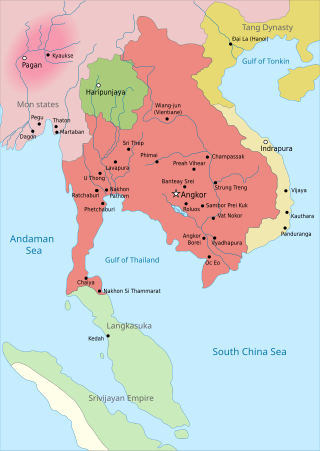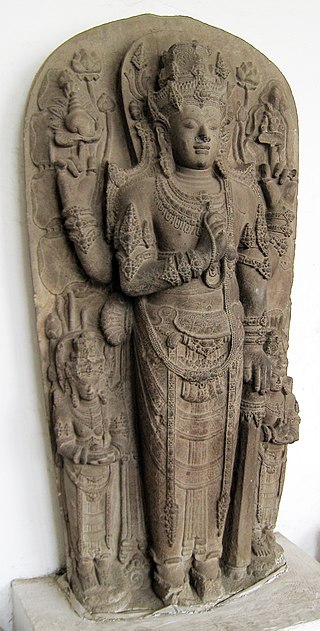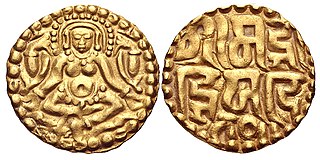
The Khmer Empire was a Hindu-Buddhist empire in Southeast Asia, centered around hydraulic cities in what is now northern Cambodia. Known as Kambuja by its inhabitants, it grew out of the former civilisation of Chenla and lasted from 802 to 1431. Historians call this period of Cambodian history the Angkor period, after the empire's most well-known capital, Angkor. The Khmer Empire ruled or vassalised most of mainland Southeast Asia and stretched as far north as southern China. At its peak, the Empire was larger than the Byzantine Empire, which existed around the same time.

Mandu or Mandavgad is an ancient city in the present-day Mandav area of the Dhar district. It is located in the Malwa and Nimar region of western Madhya Pradesh, India, at 35 km from Dhar city. In the 11th century, Mandu was the sub division of the Tarangagadh or Taranga kingdom. This fortress town on a rocky outcrop about 100 km (62 mi) from Indore is celebrated for its architecture.

The Chandelas of Jejakabhukti was an Indian dynasty in Central India. The Chandelas ruled much of the Bundelkhand region between the 9th and the 13th centuries. They belonged to the Chandel clan of the Rajputs.
Jayavarman II was a Khmer prince who founded and became the ruler of the Khmer Empire (Cambodia) after unifying the Khmer civilization. The Khmer Empire was the dominant civilization in mainland Southeast Asia from the 9th century until the mid-15th century. Jayavarman II was a powerful Khmer king who declared independence from a polity inscriptions named "Java", which most probably refers to the island of Java in the Indonesian archipelago. Jayavarman II founded many capitals such as Mahendraparvata, Indrapura, Amarendrapura, and Hariharalaya. Before Jayavarman II came to power, there was much fighting among local overlords who ruled different parts of Cambodia. The most well known opposition were the Shailendra Kings. In 781, Jayavarman II took action by claiming independence on the land of Chenla. By starting off with small weak kingdoms, he built himself up from there eventually leading to the Khmer Empire. No inscriptions by Jayavarman II have been found. Future kings of the Khmer Empire described him as a warrior and the most powerful king from that time frame that they could recall. Historians formerly dated his reign as running from 802 AD to 835 AD.

The Seuna, Sevuna, or Yadavas of Devagiri was a medieval Indian dynasty, which at its peak ruled a realm stretching from the Narmada river in the north to the Tungabhadra river in the south, in the western part of the Deccan region. Its territory included present-day Maharashtra, northern Karnataka and parts of Madhya Pradesh, from its capital at Devagiri.

The Paramara Dynasty ruled Malwa and surrounding areas in west-central India between 9th and 14th centuries. They belonged to the Parmara clan of the Rajputs.

Devaraja was a religious order of the "god-king," or deified monarch in medieval Southeast Asia. The devarāja order grew out of both Hinduism and separate local traditions depending on the area. It taught that the king was a divine universal ruler, a manifestation of Bhagavan. The concept viewed the monarch to possess transcendental quality, the king as the living god on earth. The concept is closely related to the Indian concept of Chakravarti. In politics, it is viewed as the divine justification of a king's rule. The concept was institutionalized and gained its elaborate manifestations in ancient Java and Cambodia, where monuments such as Prambanan and Angkor Wat were erected to celebrate the king's divine rule on earth.

The Chaulukya dynasty, also Solanki dynasty, was a dynasty that ruled parts of what are now Gujarat and Rajasthan in north-western India, between c. 940 CE and c. 1244 CE. Their capital was located at Anahilavada. At times, their rule extended to the Malwa region in present-day Madhya Pradesh. The family is also known as the "Solanki dynasty" in the vernacular literature. They belonged to the Solanki clan of Rajputs.
Arjunavarman II, also known as Arjuna, was an emperor of the Paramara dynasty in central India. He ruled in the Malwa region, in second half of the 13th century CE, during 1270s and 1280s.
Jayavarman II, also known as Jayasimha II, was a king of the Paramara dynasty in central India. He ruled in the Malwa region, succeeding his elder brother Jaitugi.

The Kalachuris of Tripuri, also known the Kalachuris of Chedi, ruled parts of central India during 7th to 13th centuries. They are also known as the Later Kalachuris to distinguish them from their earlier namesakes, especially the Kalachuris of Mahishmati. Their core territory included the historical Chedi region, and their capital was located at Tripuri.
Jayasimha was an Indian king from the Paramara dynasty, who ruled in the Malwa region of central India. He was the successor, and possibly a son, of the dynasty's most powerful king Bhoja. He appears to have ascended the throne with the support of the Kalyani Chalukya prince Vikramaditya VI, and appears to have been dethroned by Vikramaditya's rival brother Someshvara II.
Lakshmadeva was a member of the Paramara dynasty of Malwa region in central India. According to one theory, he ascended the Paramara throne after his father Udayaditya, and reigned during the 1080s CE. According to another theory, Lakshmadeva never became the king and Udayaditya was succeeded by Lakshmadeva's brother Naravarman.
Jayavarman, also known as Ajayavarman, was an Indian king from the Paramara dynasty, who ruled in the Malwa region of central India. He appears to have recaptured the Paramara capital Dhara after a Chaulukya occupation of the city. Sometime later, an usurper named Ballala became the control of the city, and Jayavarman appears to have moved to a newly-created principality in the Bhopal area.
Devapala was an Indian emperor from the Paramara dynasty, who ruled in the Malwa region of central India.
Jaitugi-deva was an Indian king from the Paramara dynasty, who ruled in the Malwa region of central India.
Vindhyavarman was an Indian emperor from the Paramara dynasty, who ruled in the Malwa region of central India. He defeated the Chaulukyas, who had annexed the Paramara territory to their own kingdom in the preceding years.
Yashovarman was an Indian king from the Paramara dynasty, who ruled in the Malwa region of central India. He was defeated and imprisoned by the Chaulukya king Jayasimha Siddharaja, and appears to have ruled as a Chaulukya subordinate after 1134 CE.







